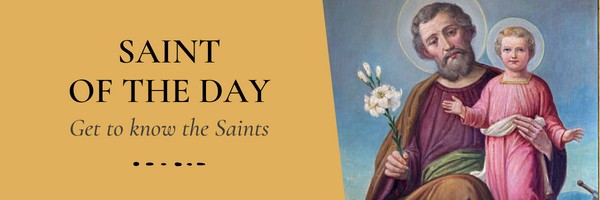 Dear readers, Catholic Online was de-platformed by Shopify for our pro-life beliefs. They shut down our Catholic Online, Catholic Online School, Prayer Candles, and Catholic Online Learning Resources essential faith tools serving over 1.4 million students and millions of families worldwide. Our founders, now in their 70's, just gave their entire life savings to protect this mission. But fewer than 2% of readers donate. If everyone gave just $5, the cost of a coffee, we could rebuild stronger and keep Catholic education free for all. Stand with us in faith. Thank you. Help Now >
Dear readers, Catholic Online was de-platformed by Shopify for our pro-life beliefs. They shut down our Catholic Online, Catholic Online School, Prayer Candles, and Catholic Online Learning Resources essential faith tools serving over 1.4 million students and millions of families worldwide. Our founders, now in their 70's, just gave their entire life savings to protect this mission. But fewer than 2% of readers donate. If everyone gave just $5, the cost of a coffee, we could rebuild stronger and keep Catholic education free for all. Stand with us in faith. Thank you. Help Now >
Friar
FREE Catholic Classes
[From Lat. frater , through O. Fr. fredre, frere, M. E. frere; It. frate (as prefix fra ); Sp. fraile (as prefix fray ); Port. fret ; unlike the other Romance languages French has but the one word frère for friar and brother].
A friar is a member of one of the mendicant orders.
USE OF THE WORD
In the early Church it was usual for all Christians to address each other as fratres or brothers, all being children of the one Heavenly Father, through Christ. Later, with the rise and growth of the monastic orders, the appellation began gradually to have a more restricted meaning; for obviously the bonds of brotherhood were drawn more closely between those who lived under the rule and guidance of one spiritual father, their abbot. The word occurs at an early date in English literature with the signification of brother, and from the end of the thirteenth century it is in frequent use referring to the members of the mendicant orders, e.g. c. 1297, "frere prechors" (R. Glouc. 10105); c. 1325, "freres of the Carme and of Saint Austin" (Pol. Songs, 331), c. 1400, "frere meneours" (Maunder, xxxi, 139); c. 1400, "Sakked freres" (Rom. Rose). Shakespeare speaks of the "Friars of orders gray" (Tam. Shr., iv, i, 148). The word was also loosely applied to members of monastic and military orders, and at times to the convent of a particular order, and hence to the part of a town in which such a convent had been located.
The word friar is to be carefully distinguished in its application from the word monk . For the monk retirement and solitude are undisturbed by the public ministry, unless under exceptional circumstances. His vow of poverty binds him strictly as an individual but in no way affects the right of tenure of his order. In the life of the friar, on the contrary, the exercise of the sacred ministry is an essential feature, for which the life of the cloister is considered as but an immediate preparation. His vow of poverty, too, not only binds him as an individual to the exercise of that virtue, but, originally at least, precluded also the right of tenure in common with his brethren. Thus originally the various orders of friars could possess no fixed revenues and lived upon the voluntary offerings of the faithful. Hence their name of mendicants. This second feature, by which the friar's life differs so essentially from that of the monk, has become considerably modified since the Council of Trent . In Session XXV, ch. iii, "De Regular.", all the mendicant orders -- the Friars Minor and Capuchins alone excepted -- were granted the liberty of corporate possession. The Discalced Carmelites and the Jesuits have availed themselves of this privilege with restrictions (cf. Wernz, Jus Decretal., III, pt. II, 262, note). It may, however, be pertinently remarked here that the Jesuits, though mendicants in the strict sense of the word, as is evident from the very explicit declaration of St. Pius V (Const. "Cum indefessæ", 1571), are classed not as mendicants or friars, but as clerics regular, being founded with a view to devoting themselves, even more especially than the friars, to the exercise of the sacred ministry (Vermeersch, De Relig., I, xii, n. 8).
ORDERS OF FRIARS
The orders of friars are usually divided into two classes: the four great orders mentioned by the Second Council of Lyons (can. xxiii) and the lesser orders. The four great orders in their legal precedence are: (1) the Dominicans ( St. Pius V, Const. "Divina", 1568); (2) the Franciscans ; (3) the Carmelites, (4) the Augustinians.
- The Dominicans, or Friars Preachers, formerly known as the Black Friars, from the black cappa or mantle worn over their white habit, were founded by St. Dominic in 1215 and solemnly approved by Honorius III, in Dec., 1216. They became a mendicant order in 1221.
- The Franciscans, or Friars Minor (Grey Friars), were founded by St. Francis of Assisi, who is rightly regarded as the patriarch of the mendicant orders. His rule was orally approved by Innocent III in 1209 and solemnly confirmed by Honorius III in 1223 (Const. "Solet"). It is professed by the Friars Minor, the Conventuals, and the Capuchins.
- The Carmelites, or White Friars, from the white cloak which covers their brown habit, were founded as a purely contemplative order, but became mendicants in 1245. They received the approbation of Honorius III (Const. "Ut vivendi", 30 Jan., 1226) and later of Innocent IV (Const. "Quæ honorem", 1247). The order is divided into two sections, the Calced and Discalced Carmelites.
- The Augustinians, or Hermits of St. Augustine (Austin Friars), trace their origin to the illustrious Bishop of Hippo. The various branches which subsequently developed were united and constituted from various bodies of hermits a mendicant order by Alexander IV (Const. "Iis, quæ", 31 July, 1255, and Const. "Licet", 4 May, 1256).
The so-styled lesser orders, of which the following are today the most flourishing, were founded and approved at various subsequent periods: the Minims (1474), the Third Order Regular of St. Francis (1521); the Capuchin -- as constituting a different branch of the Franciscan Order -- (1525); the Discalced Carmelites -- as constituting a distinct branch of the Carmelites -- (1568); the Discalced Trinitarians (1599); the Order of Penance, known in Italy as the Scalzetti (1781).
Join the Movement
When you sign up below, you don't just join an email list - you're joining an entire movement for Free world class Catholic education.
An Urgent Message from Sister Sara – Please Watch
- Advent / Christmas
- 7 Morning Prayers
- Mysteries of the Rosary
- Litany of the Bl. Virgin Mary
- Popular Saints
- Popular Prayers
- Female Saints
- Saint Feast Days by Month
- Stations of the Cross
- St. Francis of Assisi
- St. Michael the Archangel
- The Apostles' Creed
- Unfailing Prayer to St. Anthony
- Pray the Rosary
![]()
Copyright 2025 Catholic Online. All materials contained on this site, whether written, audible or visual are the exclusive property of Catholic Online and are protected under U.S. and International copyright laws, © Copyright 2025 Catholic Online. Any unauthorized use, without prior written consent of Catholic Online is strictly forbidden and prohibited.
Catholic Online is a Project of Your Catholic Voice Foundation, a Not-for-Profit Corporation. Your Catholic Voice Foundation has been granted a recognition of tax exemption under Section 501(c)(3) of the Internal Revenue Code. Federal Tax Identification Number: 81-0596847. Your gift is tax-deductible as allowed by law.









